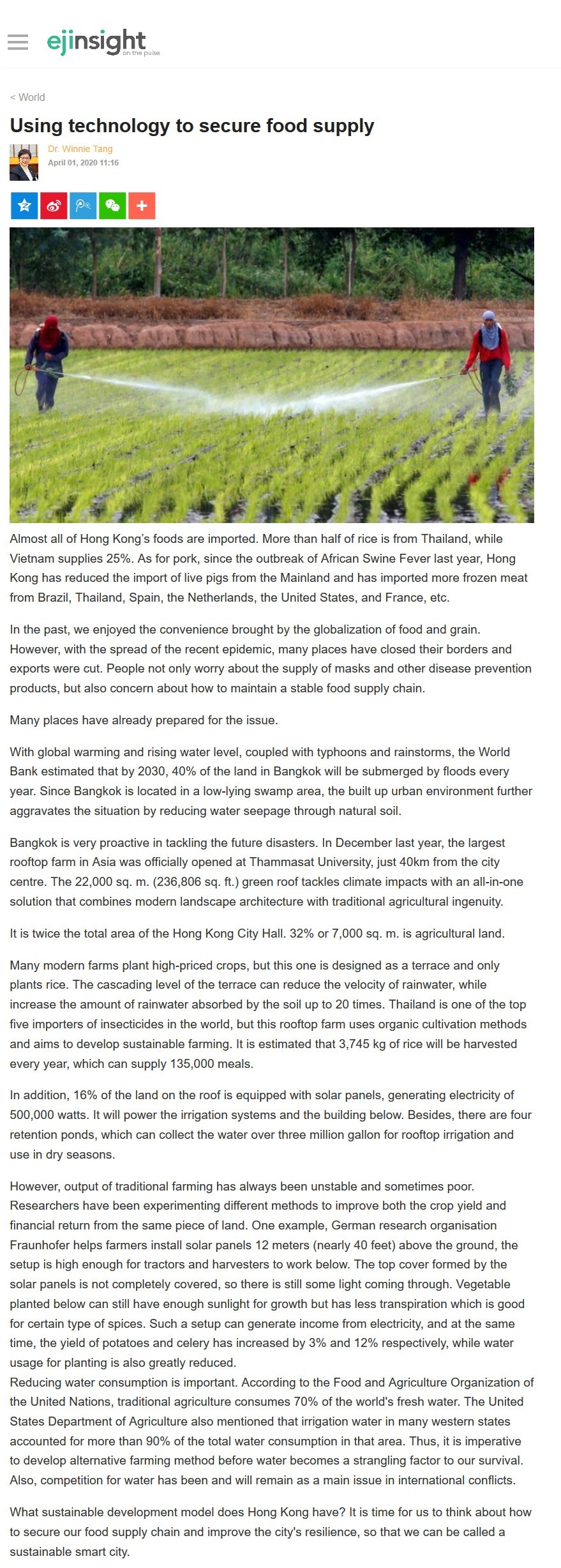網上版請按此

Using technology to secure food supply
Almost all of Hong Kong's foods are imported. More than half of rice is from Thailand, while Vietnam supplies 25%. As for pork, since the outbreak of African Swine Fever last year, Hong Kong has reduced the import of live pigs from the Mainland and has imported more frozen meat from Brazil, Thailand, Spain, the Netherlands, the United States, and France, etc.
In the past, we enjoyed the convenience brought by the globalization of food and grain. However, with the spread of the recent epidemic, many places have closed their borders and exports were cut. People not only worry about the supply of masks and other disease prevention products, but also concern about how to maintain a stable food supply chain.
Many places have already prepared for the issue.
With global warming and rising water level, coupled with typhoons and rainstorms, the World Bank estimated that by 2030, 40% of the land in Bangkok will be submerged by floods every year. Since Bangkok is located in a low-lying swamp area, the built up urban environment further aggravates the situation by reducing water seepage through natural soil.
Bangkok is very proactive in tackling the future disasters. In December last year, the largest rooftop farm in Asia was officially opened at Thammasat University, just 40km from the city centre. The 22,000 sq. m. (236,806 sq. ft.) green roof tackles climate impacts with an all-in-one solution that combines modern landscape architecture with traditional agricultural ingenuity.
It is twice the total area of the Hong Kong City Hall. 32% or 7,000 sq. m. is agricultural land.
Many modern farms plant high-priced crops, but this one is designed as a terrace and only plants rice. The cascading level of the terrace can reduce the velocity of rainwater, while increase the amount of rainwater absorbed by the soil up to 20 times. Thailand is one of the top five importers of insecticides in the world, but this rooftop farm uses organic cultivation methods and aims to develop sustainable farming. It is estimated that 3,745 kg of rice will be harvested every year, which can supply 135,000 meals.
In addition, 16% of the land on the roof is equipped with solar panels, generating electricity of 500,000 watts. It will power the irrigation systems and the building below. Besides, there are four retention ponds, which can collect the water over three million gallon for rooftop irrigation and use in dry seasons.
However, output of traditional farming has always been unstable and sometimes poor. Researchers have been experimenting different methods to improve both the crop yield and financial return from the same piece of land. One example, German research organisation Fraunhofer helps farmers install solar panels 12 meters (nearly 40 feet) above the ground, the setup is high enough for tractors and harvesters to work below. The top cover formed by the solar panels is not completely covered, so there is still some light coming through. Vegetable planted below can still have enough sunlight for growth but has less transpiration which is good for certain type of spices. Such a setup can generate income from electricity, and at the same time, the yield of potatoes and celery has increased by 3% and 12% respectively, while water usage for planting is also greatly reduced.
Reducing water consumption is important. According to the Food and Agriculture Organization of the United Nations, traditional agriculture consumes 70% of the world's fresh water. The United States Department of Agriculture also mentioned that irrigation water in many western states accounted for more than 90% of the total water consumption in that area. Thus, it is imperative to develop alternative farming method before water becomes a strangling factor to our survival. Also, competition for water has been and will remain as a main issue in international conflicts.
What sustainable development model does Hong Kong have? It is time for us to think about how to secure our food supply chain and improve the city's resilience, so that we can be called a sustainable smart city.
Dr. Winnie Tang
Adjunct Professor, Department of Computer Science, Faculty of Engineering and Faculty of Architecture, The University of Hong Kong